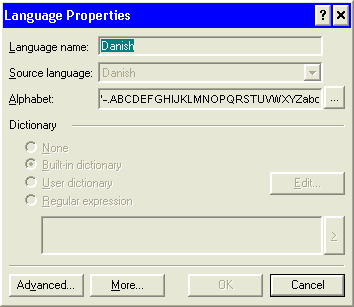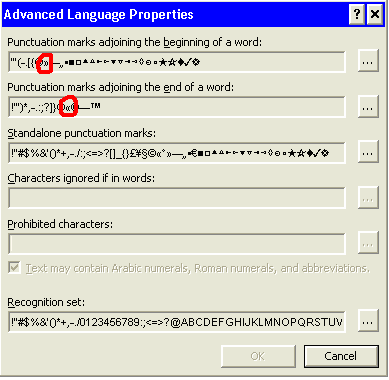Execute can not be pardoned
A couple of years ago I read a wonderful book by Lynne Truss on punctuation “Eats, Shoots & Leaves” (in the Russian translation “Execute can not be pardoned”). The author enthusiastically talks about the role of familiar punctuation marks, primarily in English. Many people can add this story exclusively with Russian realities, but I have at my disposal a treasure trove of world wisdom - the moneybox of recognition system heuristics. Therefore, I have the opportunity to tell in more detail about the world traditions of punctuation. Maybe someone will be curious.
Let's start with the fact that everyone already knows. The first and trivial remarks will touch on the differences between Russian and English. We use two kinds of quotes in Russian - “paws” “+” and “Christmas trees” - “+”. Somewhat less often we use the upper and lower paws "+". In English, quotes, Christmas trees are traditionally not used, but used single paws '+'. Lynn Truss recommends using single quotes for quotes within a quotation, and double quotes for direct speech. Not everyone follows her recommendations, but the Americans acted wisely in their own way, rejecting single quotes. I think that the role of single quotes is played by double, and the role of double quotes is by quotes. The lower opening quote is rather an unsuccessful experiment with punctuation.
Think it's all about quotes? Not here it was! Let's open the description of the Danish language in ABBYY FineReader
')


Yes, in the Danish language used quotes, Christmas trees. But in a very unusual way. The opening quote looks like this, "and the closing quote looks like this." The quotes there do not play the role of brackets, as in Russian, but the role of arrows, which indicate the direct speech between them: "here it is, you need a quote, do not confuse!"
It is also interesting that Swedes approached the use of Christmas tree quotes. They have a closing and opening quote look the same - like this. " A closing it, or opening, can be understood by the presence of a space.
Speaking of spaces. The presence of a space before a comma, a comma, a question and an exclamation mark personally jars me up. But the French and Italians - on the contrary. Moreover, they sometimes even quotes, Christmas trees are separated from the main text by spaces. Well at least that they write these quotes in the usual way for us. But the Danes with the understanding of the Italian text, probably have problems ...
About the Spanish inverted question marks and exclamation marks at the beginning of the sentence, I think many people know. Lynn Truss mentions them. But in a row written question and exclamation marks to indicate a puzzled or indignant question, not everyone uses it. According to our observations, this ending of the sentence is characteristic only for Cyrillic languages, as well as for Latvian. Moreover, in Russian it is customary to write first a question mark, and then an exclamation mark, and in Latvian - in any order. Does any sense depend on the order in which the exclamation mark and the question mark are written, I do not know. Apparently, the symbol not everyone in the world may need it :)
not everyone in the world may need it :)
By the way, about the wonderful humpback question mark. In addition to the already mentioned spaces in front of him and combining with an exclamation mark, he has a funny feature disguised as a semicolon (or, as the English speakers call them, semi-double-string). Well, or we can say that instead of our humpback in Greek (yes, it is in this) the semicolon is used. These Greeks, of course, are inventors, but at least the rest of the signs were left unchanged. What can not be said about our Armenian friends. Like this looks like an armenian question mark
looks like an armenian question mark  exclamatory. And their point is indistinguishable from our colon.
exclamatory. And their point is indistinguishable from our colon.
Well, since we are talking about Armenians, it is impossible not to mention the Jews - not only in my mind, these two peoples are somehow united. In fact, Jews do not have so many features of punctuation, except that dots in fonts are often drawn in the form of a square drawn up by an angle. Yes, and the same our question mark when writing from right to left is, proudly turned his back to the question sentence.
Maybe, you should also write about amazing Far Eastern points in the middle of the line, Japanese point and Japanese comma
and Japanese comma  , but the writing of the Far East deserves a separate story, and without consulting with Julia Dreimis ( dalimon ), who spoke so beautifully about the Chinese keyboard , I will not tell anything, because I’m afraid to completely disgrace myself :) Because of this I finish my story.
, but the writing of the Far East deserves a separate story, and without consulting with Julia Dreimis ( dalimon ), who spoke so beautifully about the Chinese keyboard , I will not tell anything, because I’m afraid to completely disgrace myself :) Because of this I finish my story.
Dmitry Deryagin
Technology Development Department
Let's start with the fact that everyone already knows. The first and trivial remarks will touch on the differences between Russian and English. We use two kinds of quotes in Russian - “paws” “+” and “Christmas trees” - “+”. Somewhat less often we use the upper and lower paws "+". In English, quotes, Christmas trees are traditionally not used, but used single paws '+'. Lynn Truss recommends using single quotes for quotes within a quotation, and double quotes for direct speech. Not everyone follows her recommendations, but the Americans acted wisely in their own way, rejecting single quotes. I think that the role of single quotes is played by double, and the role of double quotes is by quotes. The lower opening quote is rather an unsuccessful experiment with punctuation.
Think it's all about quotes? Not here it was! Let's open the description of the Danish language in ABBYY FineReader
')


Yes, in the Danish language used quotes, Christmas trees. But in a very unusual way. The opening quote looks like this, "and the closing quote looks like this." The quotes there do not play the role of brackets, as in Russian, but the role of arrows, which indicate the direct speech between them: "here it is, you need a quote, do not confuse!"
It is also interesting that Swedes approached the use of Christmas tree quotes. They have a closing and opening quote look the same - like this. " A closing it, or opening, can be understood by the presence of a space.
Speaking of spaces. The presence of a space before a comma, a comma, a question and an exclamation mark personally jars me up. But the French and Italians - on the contrary. Moreover, they sometimes even quotes, Christmas trees are separated from the main text by spaces. Well at least that they write these quotes in the usual way for us. But the Danes with the understanding of the Italian text, probably have problems ...
About the Spanish inverted question marks and exclamation marks at the beginning of the sentence, I think many people know. Lynn Truss mentions them. But in a row written question and exclamation marks to indicate a puzzled or indignant question, not everyone uses it. According to our observations, this ending of the sentence is characteristic only for Cyrillic languages, as well as for Latvian. Moreover, in Russian it is customary to write first a question mark, and then an exclamation mark, and in Latvian - in any order. Does any sense depend on the order in which the exclamation mark and the question mark are written, I do not know. Apparently, the symbol
 not everyone in the world may need it :)
not everyone in the world may need it :)By the way, about the wonderful humpback question mark. In addition to the already mentioned spaces in front of him and combining with an exclamation mark, he has a funny feature disguised as a semicolon (or, as the English speakers call them, semi-double-string). Well, or we can say that instead of our humpback in Greek (yes, it is in this) the semicolon is used. These Greeks, of course, are inventors, but at least the rest of the signs were left unchanged. What can not be said about our Armenian friends. Like this
 looks like an armenian question mark
looks like an armenian question mark  exclamatory. And their point is indistinguishable from our colon.
exclamatory. And their point is indistinguishable from our colon.Well, since we are talking about Armenians, it is impossible not to mention the Jews - not only in my mind, these two peoples are somehow united. In fact, Jews do not have so many features of punctuation, except that dots in fonts are often drawn in the form of a square drawn up by an angle. Yes, and the same our question mark when writing from right to left is, proudly turned his back to the question sentence.
Maybe, you should also write about amazing Far Eastern points in the middle of the line, Japanese point
 and Japanese comma
and Japanese comma  , but the writing of the Far East deserves a separate story, and without consulting with Julia Dreimis ( dalimon ), who spoke so beautifully about the Chinese keyboard , I will not tell anything, because I’m afraid to completely disgrace myself :) Because of this I finish my story.
, but the writing of the Far East deserves a separate story, and without consulting with Julia Dreimis ( dalimon ), who spoke so beautifully about the Chinese keyboard , I will not tell anything, because I’m afraid to completely disgrace myself :) Because of this I finish my story.Dmitry Deryagin
Technology Development Department
Source: https://habr.com/ru/post/108864/
All Articles